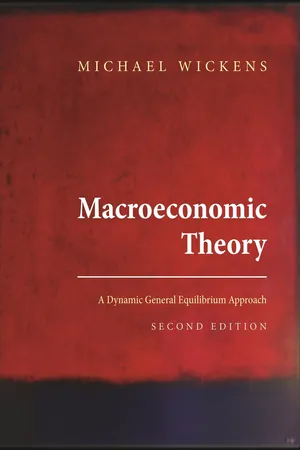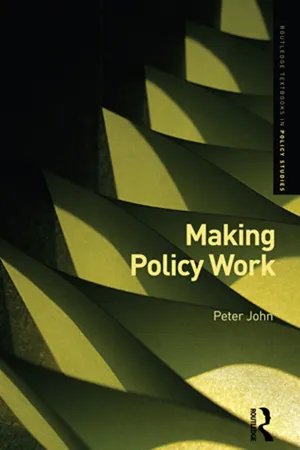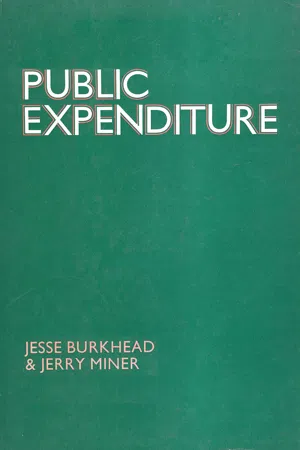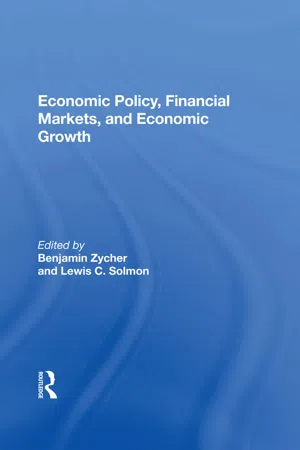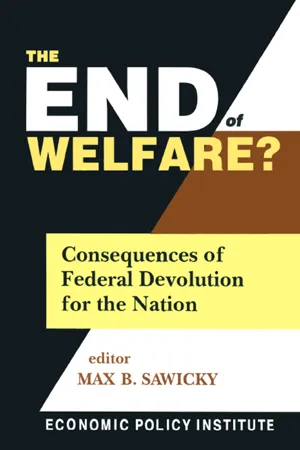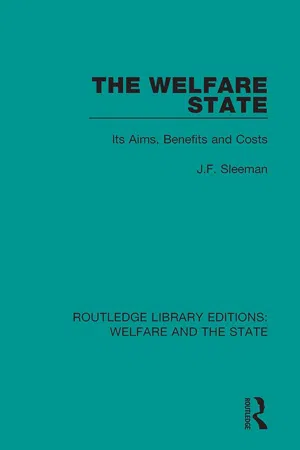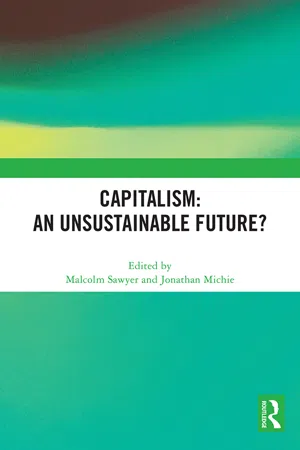Economics
State Government Expenditures
State government expenditures refer to the funds spent by state governments on various programs and services, such as education, healthcare, infrastructure, and public safety. These expenditures are a key component of a state's budget and are funded through sources like taxes, federal grants, and borrowing. Monitoring and managing state government expenditures is crucial for maintaining fiscal responsibility and meeting the needs of the population.
Written by Perlego with AI-assistance
Related key terms
12 Key excerpts on "State Government Expenditures"
- eBook - ePub
- Donijo Robbins(Author)
- 2017(Publication Date)
- Routledge(Publisher)
8 Fiscal Characteristics of Public Expenditures Suzanne Leland Department of Political Science, University ofNorth Carolina at Charlotte, Charlotte, NC8.1 Introduction
Public expenditures help educate children, keep our streets safe, help people get to and from work, and provide medical treatment to the elderly and poor, to name just a few things. They are also the playing fields for politicians. They reflect compromise, negotiation, and the interpretation of public preferences made in the halls of our capitals and state and local governments. They are part of the budgeting system that must match the revenues derived from myriad sources. Essentially, the decision to allocate public expenditures determines who gets what from government.Several economic issues are involved in the allocation of public expenditures in our federal fiscal system. Public expenditures can be defined as money allocated by governments for the provision of public goods and services. According to the U.S. Census definition, general expenditures include all expenditures with the exception of those for government utilities, liquor stores, and employee retirement funds. For the purpose of this chapter we will utilize this definition.When discussing the economic impact of public expenditures, we cannot view them in isolation. Public expenditures are part of the budgetary process. At the federal level, this means that for every tax dollar collected, there can be at least a dollar increase in government spending, also known as deficit spending (or the accumulation of debt). At the state and local government level, expenditures must match revenues because budgets are required to balance. If a state has budget shortfall of $38 billion dollars (such as California in 2003), the state must find a way to balance its books. This means cutting services, raising taxes, or a combination of both. Either way, the choices are painful. - eBook - ePub
Macroeconomic Theory
A Dynamic General Equilibrium Approach - Second Edition
- Michael Wickens(Author)
- 2012(Publication Date)
- Princeton University Press(Publisher)
Many states also provide goods and services that are not pure public goods. For these government-supplied goods one person’s consumption may well be at the cost of less consumption of these (or of other goods) by someone else. Examples are government-provided education, health, and some forms of transport. These goods and services are often provided by the state on the grounds of equity or efficiency due to economies of scale. Frequently, their public provision is a source of political controversy. Apart from government expenditures on goods and services, there are also government transfers arising from social security benefits, such as unemployment compensation, family benefits, and state pensions.Most people take it for granted that government expenditures form a substantial proportion of GDP, yet this is a relatively recent phenomenon, as can be seen from figure 5.1 , which plots government expenditures as a proportion of GDP for the United States and for the United Kingdom since 1901. Real government expenditures on goods and services and real social security benefits as a proportion of GDP have increased considerably over the last century. In 1901 they were only 2.3% of GDP for the United States and 13.5% for the United Kingdom. In most Western countries they increased from around 10–20% of GDP prior to World War I to around 40–50% after World War II. The wars themselves were the times of the greatest expansion in government expenditures. Since World War II, the shares of government expenditures in GDP have risen steadily and, apart from unemployment benefits, which vary countercyclically over the business cycle, they are not much affected by the business cycle. On average, the expenditures on goods and services and on transfers are roughly equal in size. Total government expenditures also include interest payments on government debt.Government revenues are primarily tax revenues: direct taxes on incomes and expenditure, social security taxes, and corporate taxes. The balance varies somewhat between countries, but for most developed countries direct taxes and social security taxes—which are in effect taxes on incomes—are about 60% of total tax revenue, consumption taxes are about 25%, and corporate taxes are about 10%. The average tax rate on incomes (including social security) is around 42%. Tax revenues tend to be more affected by the business cycle than expenditures. This is the main reason why government deficits tend to increase during a recession. - eBook - ePub
- Peter John(Author)
- 2011(Publication Date)
- Routledge(Publisher)
There are different definitions of the welfare state variable, which may or may not include tax expenditures – particular benefits in the tax system – and different measures of growth all generate different results. The key limitation is the account of causation as mentioned above, where it is almost impossible to disentangle economic growth from spending. What should be borne in mind is Saunders' (1986) critique, which suggests cross-national regressions are rarely able to sustain the weight of inference placed upon them, partly because they are carried out in particular time periods and with groups of countries. It is striking that after Atkinson's intervention this macro-level debate runs into the sand. The main effect of public expenditures is through some selective spending, such as in education (Barro, 1991), through investment in human capital, which in turn generates economic growth. Barro's study increases the range of cases – 90 – to outside OECD countries using data from 1960–85. Again, like the other economic studies, the growth rate is inversely related to the share of the public sector of GDP. Crucially the size of the public sector is related to the amount of private investment, which in turn contributes to growth. It should also be noted this study measures the school enrolment rate, not the expenditure. Barro separately tests whether public investment expenditure influences growth, which it does not. This result, along with the other negative findings in the economics literature, remains unchallenged. Overall, using the important case of the spending on the welfare state, a range of studies show positive impacts, either at the aggregate level or for the welfare of specific groups in the population. There remains the fear the overuse of this tool of government will crowd out other activities, such as economic growth or other beneficial self-organising activities - eBook - ePub
Public Finance
An International Perspective
- Joshua E Greene(Author)
- 2011(Publication Date)
- WSPC(Publisher)
Government tax laws, expenditure programs, and regulation all impose costs, often substantial, on the private sector. These costs do not count as government expenditures. Yet they represent part of the “burden” of government on an economy. Government building codes impose additional costs on contractors, businesses, and homeowners, for example. Paying taxes and complying with tax regulations also involve substantial amounts of time and expense for firms and households. These amounts should be remembered when figuring the “true” cost of government.Finally, many expenditure programs contain hidden taxes, in the form of reducing benefits as income rises. In some countries, subsidy rates and benefit payments for certain programs decline as income rises. For example, in the United States, an “earnings test” causes social security benefits for those younger than “full retirement age” (the age at which benefits are no longer reduced for early retirement) to be reduced by US$1 for every US$2 in earnings. Before 2000, benefits were reduced by this amount for those aged 65 to 69; before 1983, it applied to those younger than 72.5III. Main Categories of Government ExpenditureAs noted in Chapter Four, the main components of government expenditure can be classified in two ways: economically, and by function. Under the 1986 Manual on Government Finance Statistics, which most countries still use, the economic classification of government expenditure identifies three broad types of outlays: current expenditure, capital expenditure, and net lending (which represents net outlays — loans minus the repayment of principal — for government lending programs that serve policy purposes). Current expenditure comprises outlays for wages and salaries (compensation of employees), purchases of other goods and services (non-wage outlays for operations and maintenance), interest payments, and subsidies and transfers. Military outlays are usually included in current expenditure, except for identified outlays for military bases. Capital expenditure comprises all outlays for long-term projects, such as infrastructure, and spending for military installations (but not weapons or armaments). The 2001 Government Finance Statistics Manual - eBook - ePub
- Jerry Miner(Author)
- 2017(Publication Date)
- Routledge(Publisher)
The study of the statutory impact of taxes and of household and business response to taxation has produced an enormous literature on shifting and incidence and heated controversy over the relevance and usefulness of the conventional analysis. Although, as has been indicated above, taxation is not a major concern of the present work, the distribution of public expenditures are examined here. The issues involve first, attempts to assign public expenditures or the services provided by the public sector to particular groups in the economy, usually categorized by income class. A second concern is to examine reactions with regard to production, consumption, and the provision of services by decision-making individuals and firms to the availability, free of direct charge, of various public services. One rather conspicuous illustration here is the question of whether measures such as increases in welfare payments or the establishment of a guaranteed annual income reduce or increase work incentives. Less obvious is the response of businesses to increased public expenditures on police and fire protection or of households to greater public adult education. Another important facet of this same issue might be termed “expenditure capitalization” as an analogue to tax capitalization. This arises mainly when spatial considerations cause an increase or decrease in the value of real estate or real business property as a result of a public action such as the building of a park, an incinerator, an airport, or highway.These efforts at empirical analysis of the consequences of expenditure, along with similar attempts for taxation are, at best, extremely limited in scope. They do not in any way go beyond examination of impact or first round shifting toward the ultimate general equilibrium effect of taxes and expenditures. Such objectives are far beyond the capacity of present analytic and empirical techniques and appear destined to remain so.Finally, positive studies have been made of the budgetary process and the underlying political structure as a means of explaining the emergent pattern of agency requests and legislative authorizations and appropriations. Here the major research has been performed by political scientists who have examined the budgetary process at the state and federal level with regard to systematic relations between the size of the budget appropriation and individual agency requests and a variety of factors such as agency “acquisitiveness,” executive tenure, and the numbers of years a party has been in office. - Benjamin Zycher(Author)
- 2019(Publication Date)
- Routledge(Publisher)
Government Spending and TaxationPassage contains an image
Introduction
The consumption and reallocation of resources perhaps constitute the very essence of government, achieved in the main through its powers of taxation and spending. That such fiscal activity by the public sector yields both benefits and costs is beyond doubt, but the measurement of those effects remains difficult, despite much research effort over many years. This difficulty does not reduce the need for qualitative and quantitative analysis of the benefits and costs of fiscal activity, as government consumes and redirects a substantial proportion of national output in most of the world.But for market economies, in which prices are assumed to reflect the value and cost of resources, the value of government output in national accounts generally is measured as (or is assumed to be equal to) the cost of the inputs used by government; those costs usually do not reflect secondary but important effects of taxation and spending. If government is “too big”-that is, if aggregate wealth would be increased were some resources shifted away from government back to the private sector-then the national accounts are likely to overstate the value of government spending. And the secondary effects of fiscal activity imply that the government budget would understate the true economic cost of taxation and spending.Notwithstanding the existence of a vast literature on the demand and cost of public services, much work remains to be done in terms of both conceptual and empirical analysis of public sector spending and taxation, and attendant effects upon aggregate economic well-being. William A. Niskanen reports empirical findings on the effect of several types of fiscal activities upon three alternative measures of economic growth. He finds that government spending increases real GNP significantly, whereas taxes and deficit spending (i.e., future taxation) have significant negative effects. Interestingly, Niskanen finds that the economic benefits of nondefense spending not used for transfer payments-loosely, public sector nondefense investment-may be greater than the economic costs of the taxes and debt needed to finance the additional spending, at least as the benefits are measured in his econometric analysis. One possible problem with this finding is that some or much government investment could be undertaken by the private sector, and it is at least plausible that costs would fall. If that is true, it may suggest that the actual net effect of some government spending upon growth and productivity is negative, but not captured by the data.- eBook - ePub
The End of Welfare?
Consequences of Federal Devolution for the Nation
- Max B. Sawicky(Author)
- 2016(Publication Date)
- Routledge(Publisher)
FIVE Growing State Economies How Taxes and Public Services Affect Private-Sector Performance Timothy J. Bartik IntroductionThe economic effect of state and local government spending has been the object of a growing body of research. Governors and mayors want to know what they can do to increase their state or city’s economic development. Politicians, the public, and the news media often debate whether cutting taxes or increasing spending is the best strategy for improving local economic development. Spending increases and tax cuts are often advanced under the rationale that they will bring significant collateral benefits for jobs and the economy over and above their specific benefits.A more encompassing motive for research on state and local government spending and economic development is to investigate how best to expand the national economy. Growth in real wages and income has slowed in recent years, in part because U.S. productivity growth—the growth of U.S. economic output compared to labor and other inputs—has been slow. David Aschauer (1989a, b, c; 1990) and Alicia Munnell (1990a, b) argue that U.S. productivity growth is hampered by the slow growth of “public capital” (roads, mass transit, water and sewer systems, etc.). National data analyzed by these researchers show some correlation between public capital growth and U.S. productivity growth. If Aschauer and Munnell are correct, then increasing spending on public capital might boost U.S. productivity growth, thereby inducing more rapid increases in wages and incomes.Evidence based on U.S. national data is limited for a number of reasons. One is that there is not a great deal of historical, statistical experience from which to draw. Another is that correlations in the national data between public capital and productivity could be the result of unknown external factors affecting both variables, or they could simply occur by accident. - eBook - ePub
The Welfare State
Its Aims, Benefits and Costs
- J.F. Sleeman(Author)
- 2018(Publication Date)
- Routledge(Publisher)
Chapter SevenTHE ECONOMICS OF THE WELFARE STATE
In this chapter we shall be concerned to work out the economic implications of the Welfare State. What are the effects on the way in which the nation gets its living, of the diversion of such a large proportion of our national product from the incomes of individuals and firms to the recipients of cash benefits and services in kind, through taxation and the social services?First, we trace in more detail the ways in which expenditure on the social services has grown, in the present century, and especially since 1945, relative to both the national product and to Government expenditure. Then we look at the expenditure on the different branches of the social services and the ways in which this is financed. This leads on to a discussion of the main social, economic and political factors lying behind the rising trend of expenditure and of whether there are any counteracting factors. From this we go on to discuss the extent of the redistribution of incomes involved, and its consumption, savings and investment and on incentives to work and to undertake business enterprise.THE GROWTH AND DISTRIBUTION OF SOCIAL SERVICE EXPENDITURE
Table 4 shows the trends in total public expenditure, and the main categories into which it can be divided, as percentages of the gross national product. It includes all forms of Government agency, central Government, local authorities and specialized bodies such as the National Insurance Funds and the hospital boards, but not the nationalized industries, except for current or capital payments made to them from the Exchequer. It also includes both current and capital expenditure. Table 5 - Holley Ulbrich(Author)
- 2013(Publication Date)
- Routledge(Publisher)
- Revenue forecasts are based on anticipated economic conditions, which are then incorporated into formal or informal models that related the economic forecast to the tax base and, using elasticity relationship, from the tax base to revenue. These forecasts also reflect any changes in the tax structure including rates and tax expenditures. Expenditure budgeting also involves forecasts that are based primarily on inflation projections and population growth.
- The budget of any government does not usually include all revenue and expenditures. Some revenue and expenditures are recorded separately in off-budget accounts that do not pass through the legislative budget process on an annual basis. Social Security and Medicare are the most important US federal off-budget accounts, while state employee retirement systems are the largest state off-budget account. There are also separate enterprise funds at the federal as well as the state and local level for many fee-financed services such as water and sewerage.
- The form of the expenditure budget may be a line-item budget, which looks at the recipients of payments (e.g., wages, services purchased), or more likely a program budget, which allocates funds to agencies or programs so that the cost of a program can be related to its benefits.
- New or expanded programs or projects go through a variety of evaluative processes. Some budgetary processes also periodically apply such scrutiny to existing budgets. More sophisticated forms of developing expenditure budgets are performance budgeting or zero-based budgeting, but both require a great deal of paperwork and are time-consuming and expensive to implement.
- Past efforts to contain government growth at the federal level include the Gramm– Rudman Act of the 1980s and at the state and local level, tax and expenditure limitations (TELs) such as Proposition 13 in California and TABOR in Colorado. However, some TELs have had a negative impact on the quality of local public services.
- eBook - ePub
The Other Side of the Coin
Public Opinion toward Social Tax Expenditures
- Christopher G. Faricy, Christopher Ellis(Authors)
- 2021(Publication Date)
- Russell Sage Foundation(Publisher)
In this chapter, we look at both sides of the divided welfare state in order to understand not just patterns of support for social spending but also preferences for how such spending should be conducted. In particular, we more directly compare preferences for tax expenditures with preferences for direct spending. A wide variety of research suggests that spending on social policy goals is generally popular—the public is largely supportive of public efforts to improve education, assist the poor, improve infrastructure, and so on. This support usually remains strong even when people are reminded that such spending will cost tax money or interfere in some ways with private markets. But broad support for social spending faces a considerable counterweight—public dislike and distrust of the government entrusted to do that spending. A public that wants government to do and spend more in the abstract, in other words, sees significant practical barriers to government spending money efficiently and effectively.We take an experimental approach to understanding preferences for both direct and indirect social spending, focusing on differences in how citizens view government spending done through direct appropriations and spending done through tax expenditures. Our goal is to see how support for the exact same social programs changes when the delivery mechanism of those programs (direct spending or tax expenditures) changes. We find that even when holding the cost, goals, and likely outcomes of a wide variety of social policies constant, citizens would like to see benefits delivered, all else being equal, through the tax code rather than through direct government programs.Tax expenditures, because of how they deliver benefits, may provide a preferable way for government to spend money on social policy goals. Because tax expenditures are delivered privately, and in a way that does not connote “government spending” in the minds of citizens, they can provide the same kinds of social benefits as direct spending without invoking the specter of “big government” or government spending. This is especially true among people who might be especially prone to reject a large government role in shaping social policy, either for ideological reasons or simply because they distrust government.Public Attitudes Toward Government and Government SpendingThe American public has long been of two minds regarding its preference for the role of government in society. This distinction is often framed as one between operational liberalism and symbolic conservatism. When it comes to specific social policies (the operational side of public opinion), citizens generally want government to do and spend more; when they are asked about their preferences for government spending in nearly every major policy domain, the plurality response is “more spending.”1 But at the same time, citizens are more likely to identify symbolically as conservatives rather than liberals, they often express an abstract preference for a smaller and leaner government, and they reject labels that connote a preference for a larger, more activist government.2 - eBook - ePub
Local Public Finance and Economics
An International Perspective
- Harry Kitchen, Melville McMillan, Anwar Shah(Authors)
- 2019(Publication Date)
- Palgrave Macmillan(Publisher)
© The Author(s) 2019 H. Kitchen et al. Local Public Finance and Economics https://doi.org/10.1007/978-3-030-21986-4_6Begin Abstract6. Expenditures and Service Delivery: Social Services
End AbstractHarry Kitchen1,Melville McMillan2andAnwar Shah3(1) Department of Economics, Trent University, Peterborough, ON, Canada(2) University of Alberta, Edmonton, AB, Canada(3) Governance Studies, Brookings Institution, Washington, DC, USAAnwar ShahIntroduction
During the second half of the last century, there was dramatic growth in government, especially in the industrialized countries. Across 17 industrialized countries, Tanzi and Schuknecht (1995 ) report that the ratio of government expenditures (G) to GDP increased from 27.9 percent to 47.2 percent between 1960 and 1994. Growth in social spending was the main driver of that growth in government. For that group and time, social expenditures increased from 10.1 to 21.7 percent of GDP and those for subsidies and transfers rose from 8.3 to 23 percent. More recently, the G/GDP ratio has not only stabilized but has declined slightly, to where G is an average of 43.9 percent of GDP, in part due to declining interest rates and debt-servicing costs (Schuknecht and Tanzi 2004 ).1Governments have typically had a role in providing social programs and, clearly, that role has increased. Governments’ role in providing assistance for the needy has resulted because the care available from religious and volunteer groups has usually been considered insufficient (and vice versa). Also, over time, a social safety net has come to be recognized as supporting market specialization, labor mobility, and risk taking; benefits that take on more relevance as trade and international trade expands. Governments have usually played a particularly prominent role in schooling and education. The increasing importance of education and skills in the labor market has pushed the public role further as secondary education became the norm and post-secondary (vocational and academic) education is increasingly expected by employers. Advances in health services have expanded the benefits from quality medical and hospital care. While the benefits increased, so have the costs. Public health insurance has been widely adopted as a means to ensure general access at reasonable cost. Public health programs have usually included public delivery of significant components of the system, especially hospitals. Overall, public social programs have grown substantially largely because they afforded a popular means of sharing risk and of realizing growing benefits. - eBook - ePub
- Malcolm Sawyer, Jonathan Michie, Malcolm Sawyer, Jonathan Michie(Authors)
- 2022(Publication Date)
- Routledge(Publisher)
Landau (1983 , 784) points out, is in fact investment in the broader sense, especially education and healthcare. Therefore, we consider government expenditure on education and healthcare as public investment expenditure. However, it is worthy to remember that, irrespective of whether it is a government consumption expenditure or an investment expenditure, government expenditures on education affects labour productivity with a long time-lag. Therefore, for simplicity, we assume that government investment expenditure is mainly of a ‘core’ infrastructure type. This type of government expenditure has the potential to influence the current profitability of private investment and thus this is different from the crowding in effect where the future profitability of private capital formation is influenced.- Note that
g ∗represents the equilibrium value of investment to capital ratio(.I K)- For a give capital stock, a rise in capacity utilization rate
( u =is associated with a rise in aggregate demand. Therefore, ceteris paribus, a discussion on the effect of various parameters on u is sufficient for taking care of the formal discussion of the effect of various changes on aggregate demand.Y K)- Note that for a given capital stock K, a rise in aggregate demand is always associated with a rise in the degree of capacity utilisation
u =.Y K- Note that
. In the wage-led demand regime=du ∗d tγ 0π +s P−s W−γ 2s W2s P−s W−γ 21 − tπ +s W1 − t−γ 1−γ 3θand therefore> 0s P−s W−γ 2is unambiguously positive.du ∗d t- As total tax revenue is tY, for every unit rise in the tax rate, tax revenue (normalized by the capital stock) rises by
unit. Therefore, government expenditure and hence the aggregate demand rises by uY K= u
Index pages curate the most relevant extracts from our library of academic textbooks. They’ve been created using an in-house natural language model (NLM), each adding context and meaning to key research topics.

